Medical Sensor Market Size
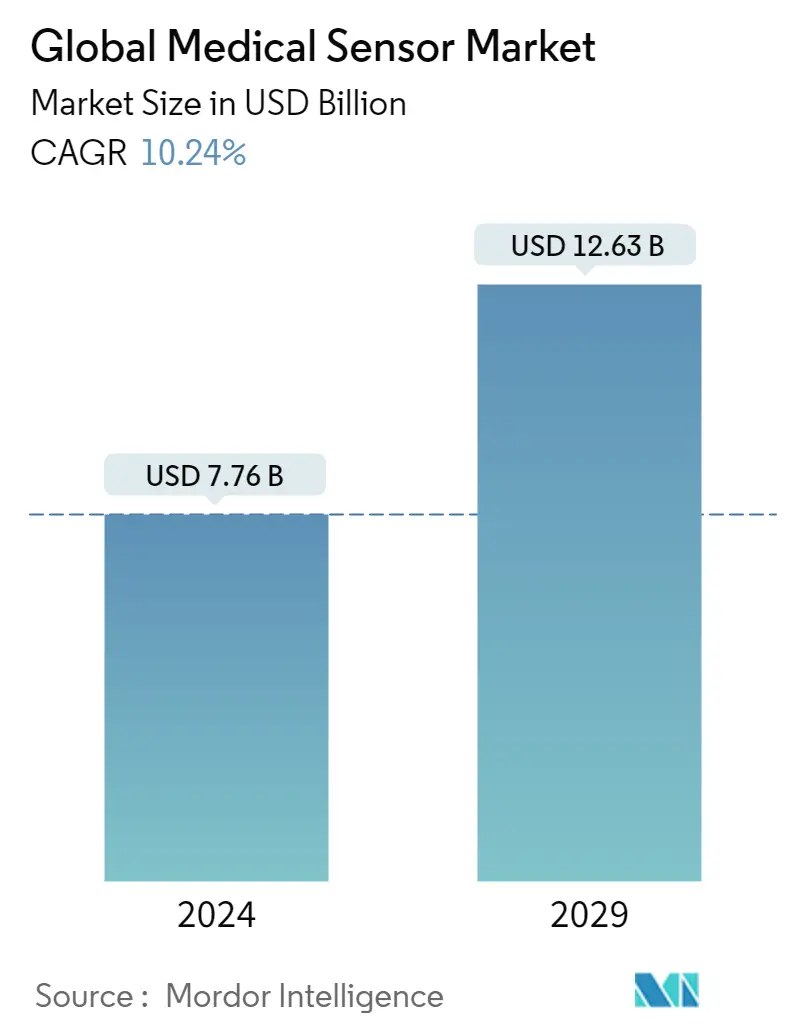
| Study Period | 2019 - 2029 |
| Market Size (2024) | USD 7.76 Billion |
| Market Size (2029) | USD 12.63 Billion |
| CAGR (2024 - 2029) | 10.24 % |
| Fastest Growing Market | Asia Pacific |
| Largest Market | North America |
Major Players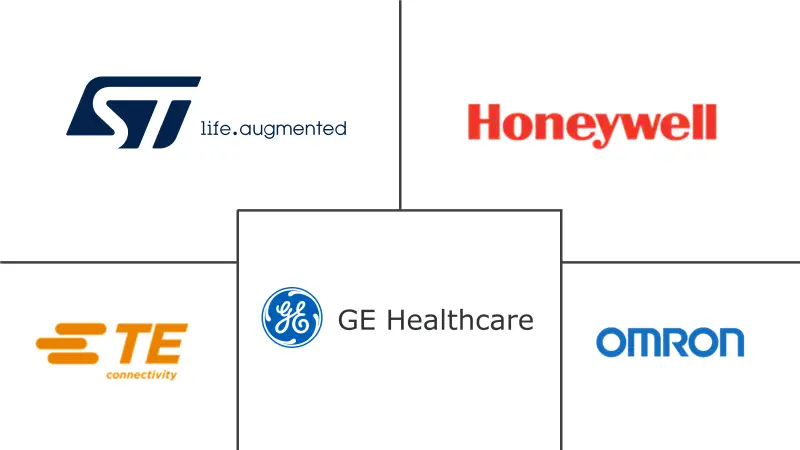
*Disclaimer: Major Players sorted in no particular order |
Need a report that reflects how COVID-19 has impacted this market and its growth?
Medical Sensor Market Analysis
The Global Medical Sensor Market size is estimated at USD 7.76 billion in 2024, and is expected to reach USD 12.63 billion by 2029, growing at a CAGR of 10.24% during the forecast period (2024-2029).
The development of new devices that provide faster analysis, lower costs, and are user-friendly contribute to the growth of the medical sensor market.
- Medical sensors are devices that respond to various physical stimuli, such as sound, pressure, heat, light, and any particular motion, and communicate the resulting impulse for examination at the point of care. Physical stimuli are converted into electrical impulses by these devices. Medical sensors offer significant benefits in disease diagnosis, treatment, and management.
- Advances in low-power electronics, MEMS technology, power harvesting, and smart materials have increased the applications of these technologies in the healthcare and medical industries. From simple medical devices to intelligent distributed healthcare systems, accurate detection, and early warning of the healthcare conditions of patients, sensors have played a major role in this industry. Furthermore, the development of unobtrusive sensing solutions has paved the path for enhanced patient health.
- Miniaturization of sensors leading to ease in integration acts as a driver to the medical sensor market. This can help in diagnosing diseases that require very detailed sensing techniques.
- Manufacturers of medical devices are putting a lot of effort into developing portable devices with sensors. Attributed to their rising usage in these devices, the demand for low-cost advanced sensors with a tiny form factor, better functionality, low power consumption, and high reliability is increasing.
- In many underdeveloped and some developing countries, the health status is still poor. This problem causes the people of these countries not to have proper access to optimal health services. Most health care systems, whether private or public, or government, are clustered in urban areas, and there is a scarcity of health services in rural belts.
- As healthcare spending for COVID-19 increases exponentially, companies that conduct research, produce test kits, implement medical sensors, develop potential vaccines, and manufacture or supply medical equipment are likely to benefit the most. Therefore, governments across the world may invest in damage control and the prevention of any potential resurgence of the pandemic. It also means that companies other than that manufacturing PPE (Personal Protective Equipment) or infrastructure support that to COVID-19 may face disruptions in business. Innovative thinking and preemptive measures may become the norm in healthcare.
Medical Sensor Market Trends
This section covers the major market trends shaping the Medical Sensor Market according to our research experts:
Pressure Sensors Play a Significant Role in the Medical Sensor Market
- Pressure sensors are crucial components for medical devices to sustain and enhance the quality of a more effective and safe operation. Furthermore, they are the reason there has been a notable increase in portable healthcare monitoring products since they have become an integral part of designing medical applications.
- Pressure sensors can monitor a patient's condition by providing definite and reliable diagnostics in a broad range of conditions. This can include monitoring oxygen therapy effectiveness in oxygen concentrators, automating drug infusion by administering the correct volume and rate of fluid in infusion pumps, or even measuring blood pressure.
- Moreover, many people suffer from asthma attacks and use inhalers as a solution. Poor inhaler techniques prevent patients from receiving their full therapeutic benefits. In order to counter this situation, leading medical equipment manufacturers are employing pressure sensors in inhalers, and individuals are starting to receive proper asthma care measures.
- Wearable pressure sensors are commonly used in medicine to track vital signs and robotics to help mechanical fingers handle delicate objects. Conventional soft capacitive pressure sensors only work at pressures below 3 kPa, however, meaning that something as simple as tight-fitting clothing can hinder their performance.
- In August 2021, an Indian researcher developed low-cost, flexible, and wearable sensors that can be used for the diagnosis of pulse rate variability in humans. Being a high sensitivity flexible pressure and strain sensor, it can also be used for small- and large-scale motion monitoring, with potential applications in robotics prosthetics, as well as minimally invasive surgery and identification of tumor/cancerous cells.
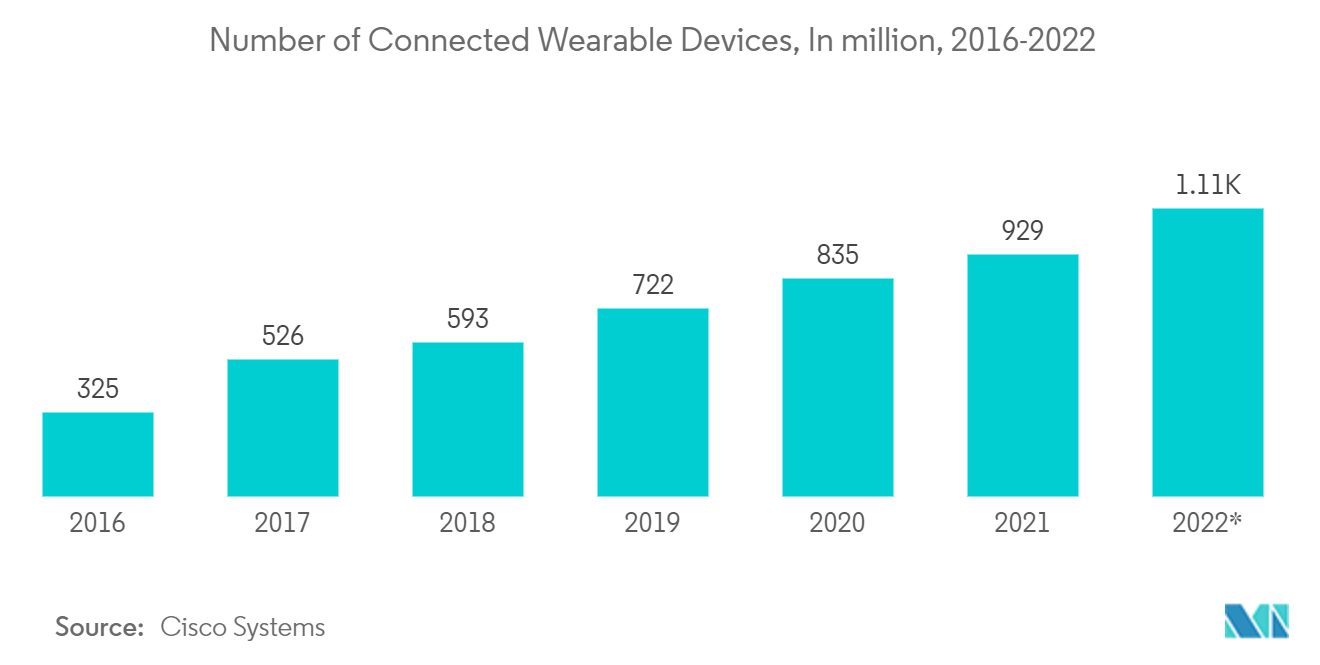
North America to Record a Significant Growth Rate Over the Forecast Period
- The medical device market size in North America is one of the largest among other regions and is expected to grow at a considerable growth rate during the forecast period. The factors such as a well-developed healthcare infrastructure, presence of adequate and favorable reimbursement policies, rapid adoption of advanced medical technologies, and key players within the region are responsible for the industry growth.
- Additionally, the growing number of patients undergoing diagnosis and treatment in the regions due to a rising incidence and prevalence of chronic conditions is further promoting the acceptance of advanced medical devices and associated sensors in the past few years.
- The medical device industry relies on several industries where the United States holds a competitive advantage, including microelectronics, telecommunications, instrumentation, biotechnology, and software development. Collaborations have led to recent advances, including neuro-stimulators, stent technologies, biomarkers, robotic assistance, and implantable electronic devices.
- Many federal policies, programs, and actions are being initiated by the governments of the North American region to experience progress in healthcare services. For example, within the United States, the federal government has been encouraging the use of healthcare data through various policies and initiatives. Affordable Care Act (ACA), the most important healthcare legislation in the United States, authorized the Department of Health and Human Services to release data that promotes transparency in healthcare and medical insurance markets.
- In September 2021, Gator Bio Inc. launched GatorPlus, next-generation biolayer interferometry (BLI) instrument, and two new biosensor products, Gator Flex SA Kit and Gator AAVX probe. The GatorPlus adds to the currently available GatorPrime instrument. The Gator Flex SA Kit and Gator AAVX probe expand the off-the-shelf biosensor portfolio to 14 products for the North American market. In the last few years, Health Canada has undertaken an initiative to adapt its regulatory approach to better support digital health technologies, specifically medical devices.
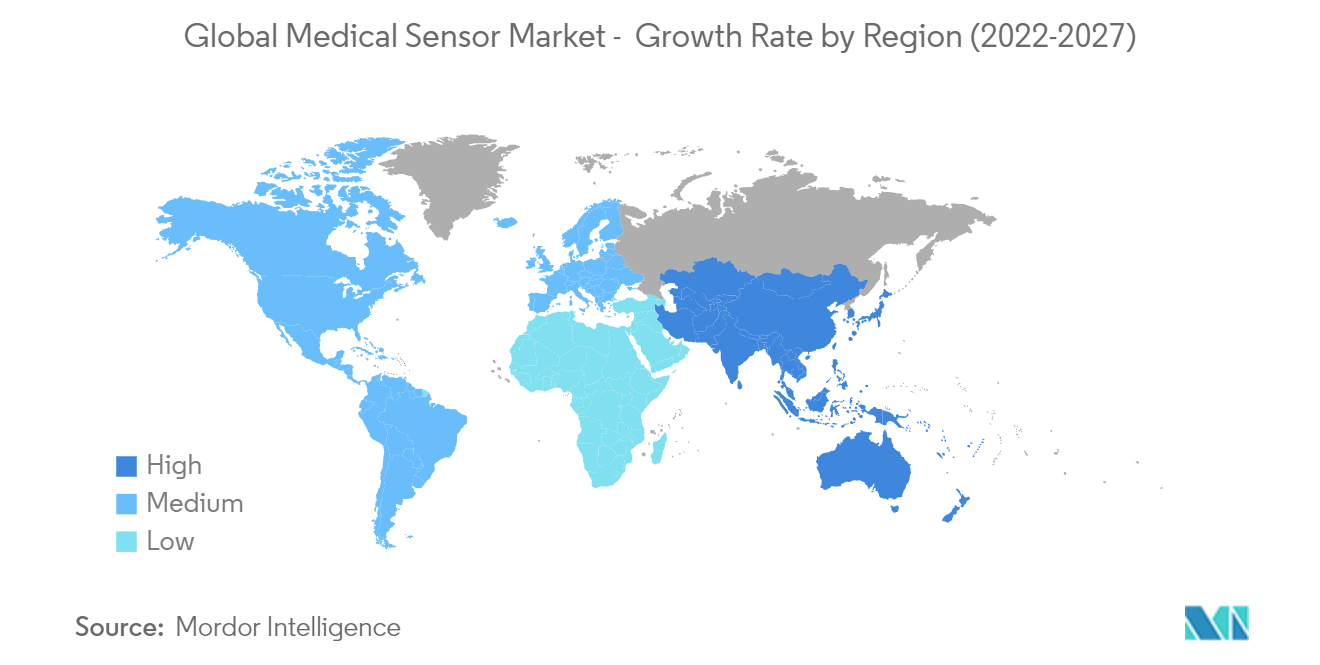
Medical Sensor Industry Overview
The major players in the market are GE Healthcare Inc., STMicroelectronics, Honeywell Inc., Omron Corporation, Siemens Corporation, and others. The market is dominated by these players; hence the market is consolidated. Thus, the market concentration will be low.
- October 2021 - OMRON updated Automation Center in Barcelona. The new facility cements OMRON's position as a prominent provider in factory automation technology that addresses various challenges. OMRON transforms automation concepts into innovative solutions with the support of the Automation Center. The exhibits aim to showcase OMRON's i-Automation and the concept of integrated, interactive, and intelligent solutions, including its extensive portfolio of control, motion, vision, safety, robotics technologies, and worldwide engineering and services capabilities.
- September 2021 - Sensirion Holding AG, a prominent provider of environmental and flow sensor solutions, has completed the purchase of AiSight GmbH, a pioneer in scalable, easy-to-use machine diagnostics. AiSight, situated in Berlin, develops and sells plug-and-play solutions for the rapidly increasing industrial condition monitoring and predictive maintenance sector. AiSight's technology uses vibration and temperature sensors and artificial intelligence data processing to help industrial organizations reduce unplanned downtime and improve the quality of their production processes.
Medical Sensor Market Leaders
GE Healthcare Inc.
STMicroelectronics
Honeywell International Inc.
Omron Corporation
TE Connectivity Ltd
*Disclaimer: Major Players sorted in no particular order
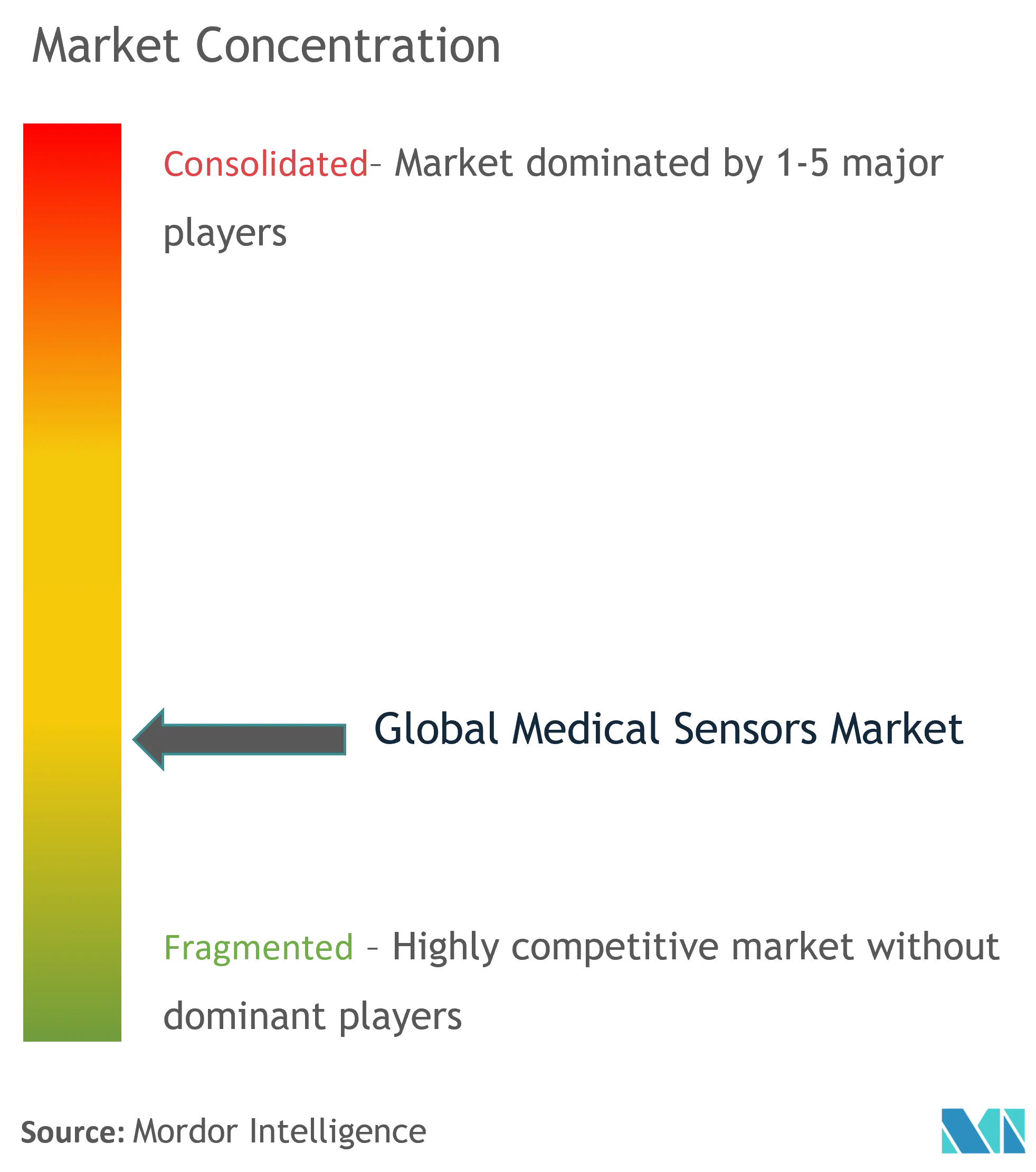
Medical Sensor Market News
- August 2022 - Sibel Health announced raising USD 33 million in its Series B financing round. The funding aims to scale wearable sensors for remote monitoring in the hospital.
- August 2022 - A team at Nottingham Trent University and Nottingham University Hospitals NHS Trust has developed a new biosensor capable of accurately monitoring the condition of a chronic wound. The aim is for the technology to be embedded into dressings so that they do not need to be continually removed and replaced to assess how an injury is healing.
- September 2021 - TE Connectivity Ltd acquired three companies known as Toolbox Medical Innovations, Wi Inc., and micro liquid. The combined entities will leverage US and European design and manufacturing capabilities to serve its global customer base.
- May 2021 - Honeywell announced that Dnata USA expanded its deployment of Honeywell ThermoRebellion temperature monitoring solution to support domestic and international passengers at Boston Logan International Airport. Honeywell's solution was designed and tested to meet the recommendations set by the US Food and Drug Administration Enforcement Policy for Telethermographic Devices in April 2020 to address the usage of thermal imaging systems during the COVID-19 pandemic.
Medical Sensor Market Report - Table of Contents
1. INTRODUCTION
1.1 Study Assumptions and Market Definition
1.2 Scope of the Study
2. RESEARCH METHODOLOGY
3. EXECUTIVE SUMMARY
4. MARKET INSIGHT
4.1 Market Overview
4.2 Industry Value Chain Analysis
4.3 Industry Attractiveness - Porter's Five Forces Analysis
4.3.1 Bargaining Power of Suppliers
4.3.2 Bargaining Power of Buyers
4.3.3 Threat of New Entrants
4.3.4 Threat of Substitutes
4.3.5 Intensity of Competitive Rivalry
4.4 Assessment of the Impact of COVID-19 on the Market
5. MARKET DYNAMICS
5.1 Market Drivers
5.1.1 Miniaturization of Sensors Leading to Ease in Integration
5.1.2 Increasing Advancement in Medical Devices and Accessories
5.2 Market Challenges
5.2.1 Slower Rate of Penetration of Advanced Medical Systems in Developing Regions
5.2.2 Stringent Regulatory Environment for Product Approvals
6. MARKET SEGMENTATION
6.1 By Component
6.1.1 Flow Sensor
6.1.2 Biosensor
6.1.3 Temperature Sensor
6.1.4 Pressure Sensor
6.1.5 Other Types
6.2 By Application
6.2.1 Clinical Applications
6.2.2 Consumer Applications
6.3 By Geography
6.3.1 North America
6.3.2 Europe
6.3.3 Asia Pacific
6.3.4 Latin America
6.3.5 Middle East and Africa
7. COMPETITIVE LANDSCAPE
7.1 Company Profiles
7.1.1 GE Healthcare Inc
7.1.2 STMicroelectronics NV
7.1.3 Honeywell International Inc.
7.1.4 TE Connectivity Ltd (First Sensors AG)
7.1.5 Omron Corporation
7.1.6 Servoflo Corporation
7.1.7 Sensirion Holding AG
7.1.8 Siemens AG
7.1.9 NXP Semiconductors (Freescale Semiconductor)
7.1.10 Amphenol Advanced Sensors (Amphenol Corporation)
- *List Not Exhaustive
8. INVESTMENT ANALYSIS
9. FUTURE OF THE MARKET
Medical Sensor Industry Segmentation
Medical sensors are sophisticated sensors that create a monitoring system and have a higher significance value. They decrease human errors, respond to physical stimulus, and find application in various forms, like checking/monitoring alcohol levels in the blood, biomechanics, blood analysis, breath analysis, eye parameters, and many others. The use of sensors is not limited to patient care; it is also used in tracking the movement of pharmaceutical and other test materials related to patients.
The global medical sensor market is segmented by type (flow sensor, biosensor, temperature sensor, pressure sensor), application (clinical application, consumer application), and geography.
| By Component | |
| Flow Sensor | |
| Biosensor | |
| Temperature Sensor | |
| Pressure Sensor | |
| Other Types |
| By Application | |
| Clinical Applications | |
| Consumer Applications |
| By Geography | |
| North America | |
| Europe | |
| Asia Pacific | |
| Latin America | |
| Middle East and Africa |
Medical Sensor Market Research FAQs
How big is the Global Medical Sensor Market?
The Global Medical Sensor Market size is expected to reach USD 7.76 billion in 2024 and grow at a CAGR of 10.24% to reach USD 12.63 billion by 2029.
What is the current Global Medical Sensor Market size?
In 2024, the Global Medical Sensor Market size is expected to reach USD 7.76 billion.
Who are the key players in Global Medical Sensor Market?
GE Healthcare Inc., STMicroelectronics, Honeywell International Inc., Omron Corporation and TE Connectivity Ltd are the major companies operating in the Global Medical Sensor Market.
Which is the fastest growing region in Global Medical Sensor Market?
Asia Pacific is estimated to grow at the highest CAGR over the forecast period (2024-2029).
Which region has the biggest share in Global Medical Sensor Market?
In 2024, the North America accounts for the largest market share in Global Medical Sensor Market.
What years does this Global Medical Sensor Market cover, and what was the market size in 2023?
In 2023, the Global Medical Sensor Market size was estimated at USD 7.04 billion. The report covers the Global Medical Sensor Market historical market size for years: 2019, 2020, 2021, 2022 and 2023. The report also forecasts the Global Medical Sensor Market size for years: 2024, 2025, 2026, 2027, 2028 and 2029.
Medical Sensor Industry Report
Statistics for the 2024 Medical Sensor market share, size and revenue growth rate, created by Mordor Intelligence™ Industry Reports. Medical Sensor analysis includes a market forecast outlook to 2029 and historical overview. Get a sample of this industry analysis as a free report PDF download.
